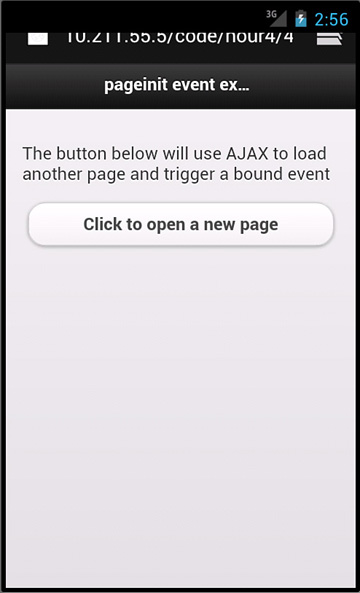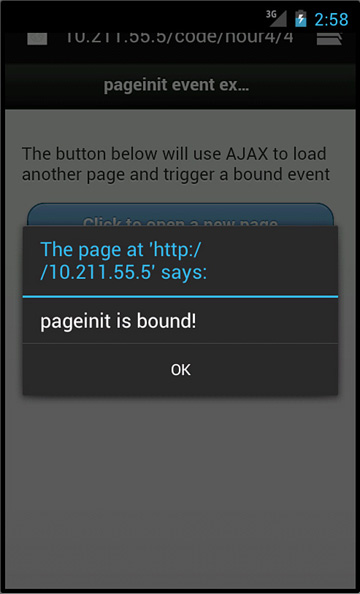- Adding jQuery Mobile to Your Site
- Using Data Roles
- Creating a Simple Page
- Understanding the Mobile Initialization Event
- Using the pageinit Event Instead of $(document).ready()
- Summary
- Q&A
- Workshop
Using the pageinit Event Instead of $(document).ready()
To use the pageinit event on your page, you have to take a slightly less dynamic and more planned approach to your code. There are a few different ways you can attach the pageinit event in your code. When using a version of jQuery Mobile prior to 1.1, you will be using jQuery 1.6.4, which means you use the .bind() function instead of the .on() function. When using jQuery Mobile 1.1+ you use the .on() function to bind the event.
The .on() function introduced in jQuery 1.7 is a unification of previous functions used to bind events. Instead of having to worry about using .bind(), .live(), or .delegate(), you can now use the .on() function to find events. More about this function can be found by visiting http://api.jquery.com/on/. If you are using a version of jQuery Mobile prior to 1.1, you should not use the .on() method, but should instead use the .delegate() or .live() function.
In Listing 4.6 the contents of multipage_one.html, which is the first page of a multipage site are shown. It includes a button that then loads a second page through AJAX.
Listing 4.6 A Page Containing the Setup for the pageinit Event
1: <!DOCTYPE html>
2: <html>
3: <head>
4: <title>Developing with jQuery Mobile</title>
5: <meta name="viewport" content="width=device-width, initial-scale=1">
6: <link rel="stylesheet" href="http://code.jquery.com/mobile/1.1.0/jquery.mobile-1.1.0.min.css" />
7: <script src="https://code.jquery.com/jquery-1.7.1.min.js"></script>
8: <script type="text/javascript">
9: $(document).on("mobileinit", function() {
10: $.extend( $.mobile , {
11: pageLoadErrorMessage: 'Either the page cannot be found or it cannot be loaded.'
12: });
13: });
14: $(document).on("pageinit","#pageinit2", function() {
15: alert("pageinit is bound!");
16: });
17: </script>
18: <script src="https://code.jquery.com/mobile/1.1.0/jquery.mobile-1.1.0.min.js"></script>
19: </head>
20: <body>
21: <div data-role="page">
22: <div data-role="header"><h1>pageinit event example</h1></div>
23: <div data-role="content">
24: <p>The button below will use AJAX to load another page and trigger a bound event</p>
25: <a href="multipage_two.html" data-role="button">Click to open a new page</a>
26: </div>
27: </div>
28: </body>
29: </html>
Looking at the preceding code, do you see the .on() function and the pageinit event? Let’s walk through the code and I will explain what we have done and how it makes things work.
The beginning lines should seem familiar by now, so we’ll start at line 9. Line 9 uses $(document) as the selector, and then uses the .on() function to bind the mobileinit event to the current page. In comparison line 14 also uses the .on() function to bind the pageinit event. The binding takes place through the second parameter passed in the .on() function. The .on() function allows events to be delegated to elements that do not currently exist in the DOM, but that will exist in the future. This is why the pageinit event will be bound to the object that will have an id of pageinit2 once it is added to the DOM.
Continuing onto line 15 we can see that an alert() function is going to be called as soon as the page is initialized into the DOM. Line 16 then closes the .on() function.
Continuing onto line 18 we see the include for jQuery Mobile. Line 19 closes the head element. Line 20 starts the body element. Lines 21 through 27 make up the actual code that will be presented as a page to the user. Line 25 shows the setup for a button, and if you look closely you see that our button is set to link to another file instead of an anchor tag farther down the page. We cover multipage sites in Hour 7, “Learning About Page Layout.”
To finish out the file, lines 28 and 29 are closing tags for the body and html elements that complete our page.
We set up a function inside the pageinit event that triggers anytime a page with an id of pageinit2 is loaded. Even though we are binding the pageinit event on the first page, it will not run on there because it does not have an id of pageinit2.
Now let’s look at Listing 4.7, which shows the contents of multipage_two.html and is the second page that Listing 4.6 links to.
Listing 4.7 This Page Has an Event Tied to It That Will Trigger on Page Load
1: <!DOCTYPE html> 2: <html> 3: <head> 4: <title>Developing with jQuery Mobile</title> 5: <meta name="viewport" content="width=device-width, initial-scale=1"> 6: <link rel="stylesheet" href="http://code.jquery.com/mobile/1.1.0-rc.1/jquery.mobile-1.1.0-rc.1.min.css" /> 7: <script src="https://code.jquery.com/jquery-1.7.1.min.js"></script> 8: <script src="https://code.jquery.com/mobile/1.1.0-rc.1/jquery.mobile-1.1.0-rc.1.min.js"> </script> 9: </head> 10: <body> 11: <div data-role="page" id="pageinit2"> 12: <div data-role="header"><h1>pageinit event example </h1></div> 13: <div data-role="content"> 14: <p>Fantastic! I am a new page and was loaded through AJAX.</p> 15: <a href="pageinit.html" data-role="button" data-rel="back"> Amazing, now take me back</a> 16: </div> 17: </div> 18: </body> 19:</html>
Look closely at the code for a minute and see if you can spot anything that would make it trigger an event when it loads.
A quick glance over lines 1 through 9 shows the typical setup of a mobile site. We can see the HTML5 DOCTYPE being used on line 1. The head element starts on line 3 and includes a title element set on line 4, the meta element set for mobile devices on line 5, the include for the jQuery Mobile style sheet on line 6, the include for the jQuery library on line 7, the include jQuery Mobile library on line 8, and the closing tag for the head element on line 9.
The only thing that appears different on this page from the page in Listing 4.6 is the lack of binding for both the mobileinit event and the pageinit event. Let’s keep looking down the code and see if we can see anything else.
Skipping over line 10, line 11 shows us setting up a div element with a data-role="page" attribute and an id="pageinit2". That is the line that contains the attribute that ties this whole thing together. The attribute is id="pageinit2". That is the id that we used for the .on() function to bind the pageinit event to. Since this page contains that particular id, as soon as it is loaded into the DOM it triggers the pageinit event and calls the alert function that we placed inside the event.
Continuing down the rest of the page, you can see the content section being created on line 13. We also added a button that allows us to link back to the first page being created on line 15. This button contains both a link back to the first page through the attribute href="pageinit.html" and an attribute of data-rel="back" that defaults to a sliding-back page transition to the first page. Lines 16 through 19 are closing tags for various HTML elements that complete our page.
The following figures show the use of the pageinit event. These figures were taken on an Android device running version 4.0.1. Depending on what browser and device you use, the alert message will appear styled differently. Figure 4.3 shows the page we built in Listing 4.6. Figure 4.4 shows the alert that is triggered by the function called in the pageinit event. Figure 4.5 shows the page that triggered the pageinit event and is the code from Listing 4.7.

Figure 4.3 When the button is pressed, the pageinit event will be called.

Figure 4.4 This alert message was triggered by the pageinit event.

Figure 4.5 This is the second page. It appears only after the code in the pageinit event has completed.
You can set up more pageinit events for other pages by using a unique id for each page you want like to attach the event to. By doing this you can trigger functions that you only want happening when certain pages load.